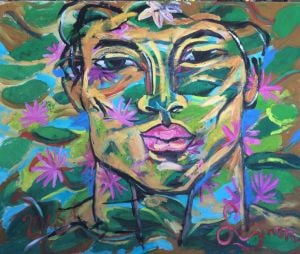A stylistic heir to Walter Spies, Le Mayeur and his mentor, the Indonesian-Dutch painter Arie Smit, Symon was among the last in the lineage of foreign artists who have helped raise Bali’s international profile as an exotic destination for art and design. Renowned for his vivid pop style with new iconic motifs, he was born on April 13, 1947, as Ronald Thomas Bierl in Detroit, Michigan, the United States, and made Bali his home in 1978. He was installed in the Puri Kaler of Ubud Palace by the Ubud royal family, who had for decades been patrons of foreign artists. Symon later took over Arie Smit’s cottage in nearby Campuhan, where his studio grew into local landmark. In 2014, he moved full-time to his other destination studio at Alas Sari in North Bali, Art Zoo, which he had founded in 1998.
Symon, who passed away on April 15, 2020 of natural causes from sepsis, was incredibly prolific and successful, creating many thousands of artworks in several countries.
His work was widely collected by tastemakers like former minister Joop Ave, especially during the 1990s and 2000s trend for Asian neotraditional style. Many collectors built submersive Symon environments, as at Qunci Villas in Lombok, West Nusa Tenggara. A book series on Southeast Asian interiors had to swap some paintings in many of its featured homes because too many of their architects and owners had put Symons on their walls.
Symon’s art is cherished for its vivid color, strong outlines and exuberant energy. His figurative paintings and sculpture project a friendly, fantastical appeal, combining the rawness of real-life models and scenes within compositions from mythology and lesser-known Bali history. His sense of line, hue and witty slogans draw from his origins as a cartoonist in the 1960s American counter-culture.
Raised in a house at the corner of Detroit’s Normal Road and Common Street, he was far from normal or common and yearned to escape convention. He was an exciting personality to be around, popping with fresh ideas. An outrageous showman, he would tell wild anecdotes and burst into rhyming raps. As a precocious teen under the pseudonym John Ka, he wrote to Beat Generation poets like Allen Ginsburg, William Burroughs and William Carlos Williams, who sent him new poems to illustrate. He soon became an artist in underground zines like Fifth Estate and got to know New York legends like Frank Zappa and Andy Warhol.
Until making Bali his permanent home, he kept trying new locations. As a youth, he twice ran away to Rome, where he studied under the sculptor Emilio Greco and got the attention of film director Federico Fellini, who dubbed him “the magician of the air”. On the overland route from Amsterdam to India, a road accident in Turkey broke his hip. While recovering he renamed himself Simon White. He finally made it to India and then went north to Nepal.
Over eight years in Kathmandu, Simon helped preserve the traditional art of Tibetan woodblock printing. With three partners he opened Himalayan antique shops in London, Amsterdam and New York. Like many “Easties”, he became expert in Asian traditional knowledge, which later infused his artworks. In the mid-1970s, Simon spent periods in the New York art scene, Colombia and Wales, England. In each new location, his studios echoed Warhol’s Factory in being a networking hub and a venue for arty “happenings”. He formed several creative teams, from the Psychic League in Rome and Fantabulous Group in Nepal to the Levitation League in Legian, Bali. In his Ubud garden, he staged theatrical productions at the amphitheater designed by the futuristic architect R. Buckminster Fuller. In each location, he trained up teams of local artisans. In Nepal he hired Tibetan refugees to carve new and replacement woodblocks to the old ones he printed from. He brought screen printing to Bali in the 1980s and then to Cambodia in Minefield Studios at Siem Reap in the early 1990s. His most famous breakthrough was JakPak, a range of convertible clothing co-created with Annie Anderson and Kiyoshi Okuda, in which pop-hued jackets and hats could turn into bags through hidden pockets. JakPak became Bali’s first clothing export and an international phenomenon collected by the likes of Mick Jagger.
Symon kept ahead of the curve, since his aim in life was constant reinvention under a motto “towards a functional reality”. Many of his creations were practical as well as fun, from JakPak to his Toyniture — quirky furnishings like his Lady Chairs and giant dining table. He conjured outlandish architecture, like his key-hole windowed pagoda at Art Zoo, which he filled with sculptures and oddities. The maximalist effect of all these “studio atmospherics” beguiled visitors and in turn became props for his paintings. The Art Zoo remains visually stunning. Symon’s heir and Art Zoo’s Balinese manager aim to reopen it as a destination where locals and tourists can continue to appreciate Symon’s distinctive art of Bali.








Enable comment auto-refresher